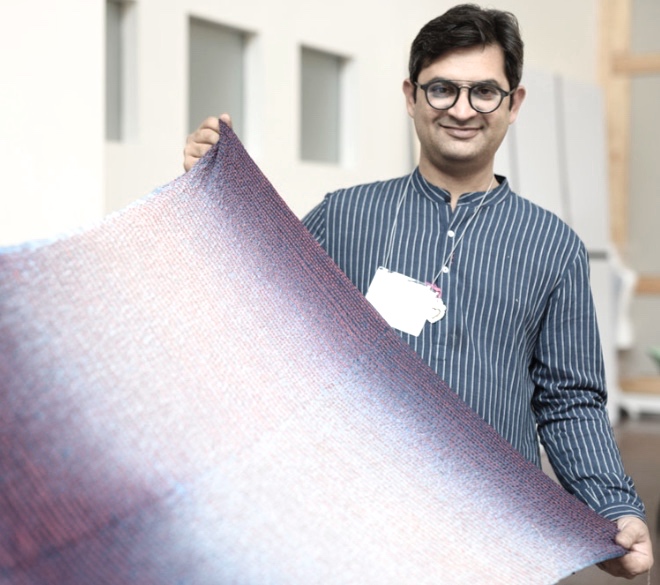“When you really understand that each color is changed by a changed environment, you eventually find that you have learned about life as well as about color.” — Josef Albers
Albers understood the power of context as it relates to color and also how it can shape our lives and creative expression. As designers we are trained to see pattern, feel texture, note asymmetry, and revel in beauty, but are we trained to see the value that context invests in the visual experience? The goal of MDS 2019 was to provide our guests the opportunity to explore this idea. We narrowed the scope of this big concept by focusing the conversation around the proposition that place – in all its constituent parts – as context, can transform design, and us, in the process.
Each of our speakers came at the topic in a variety of entertaining and visually compelling ways. Pamela Kelly set the stage by speaking about how historical, cultural and commercial factors influenced the design identity of Santa Fe; how the physical and spiritual quality of New Mexico shaped the creative expression of the many artists and creatives drawn to it; and how all these factors contributed to the formation of Santa Fe’s four extraordinary museums.
Santa Fe and its Museums represent a crossroads of culture
Using the exquisite photography from Selvedge Magazine, founder and editor Polly Leonard presented a visual tour de force of the evolution and application of some iconic textile patterns and techniques: Harris Tweed, Tartan, Madras, Batik, and Indigo. In her talk, Polly deftly wove together the history of a each pattern, how place informed its creation and how trade, fashion and commerce converged to influence the evolution and broad geographic adoption of each.
Tartan — where it started and how far it has come
Anna Murray, co-founder of UK design firm Patternity, held the audience in rapt attention as she revealed the transformative power of pattern and the value of its application in our daily life. Anna’s Patternity journey took guests from the expanse of the cosmos to the whorl of hair on a baby’s head. Along the way she shared examples of how Pattenity has forged business partnerships with such industry giants as Nike, John Lewis, AirBnB, Selfridges, Coach, Cosentino and more.
Abduljabbar Khatri spoke about his family’s centuries old involvement with the craft of bandhani – a tie dying textile tradition unique to northwestern India. Sidr Craft, the family business, works with over 250 Indian artisans skilled at tying the thousands of tiny knots that create the textile pattern. Khatri and his family then dye the goods and finish them into scarves and dresses.
Adduljabbar “untied” several dyed scarves to reveal the intricate patterns created by bandhani
Susan Hoffman, employee #8 at the legendary PR firm Wieiden + Kennedy spoke about the process behind so many of the iconic, moving and controversial advertisements for which she was the creative lead. In each and every campaign for Nike, Old Spice, Kentucky Fried Chicken, and Procter & Gamble context played a vital role. Nike’s famous brand message: Just Do It! has more power when the message is embedded in the context of a story about female athletes in India, or disabled athletes overcoming huge challenges to become storied heros. Her stirring presentation inspired everyone to remember that true creativity comes from being brave, giving voice to the truth and not being afraid to look stupid.
Museum of International Folk Art curator of North American and European Art, Laura Addison followed with a compelling presentation about how Alexander Girard’s travels and folk art collecting obsession informed his designs. Addison then went on to show how other nationally known artists’ work was informed by the place and culture they inhabit — a place called New Mexico.
The legendary and humble Hella Jongerius gave the final presentation in which she explained her design process. Jongerius beautiful products belie the effort and thoughtful consideration expended in their creation. Extremely talented in designing across multiple categories and skilled in working with many mediums, Jongerius considers the design brief, materials, makers, manufacturing process, the end use, and the environmental footprint. In accounting for the context in which she is creating, Jongerius’ designs stand above all others and remain timeless.
In the midst of all this, Summit guests had time to visit the extraordinary Museum of International Folk Art to see Alexander Girard: A Designer’s Universe, curated by the Vitra Design Museum, tour the exceptional 30,000-piece ethnographic textile collection and enjoy a paper marbling workshop led by Anna Murray.
At the conclusion, a number of guests stayed on to explore Santa Fe, and attend the astonishing Santa Fe International Folk Art Market – a gathering of 150 artists from 75 countries.
Hopefully our guests returned home refreshed, inspired and more thoughtful about the Transformative Power of Place.
How will the power of place transform you, your work, your life?



